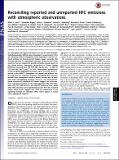Reconciling reported and unreported HFC emissions with atmospheric observations
Author(s)
Lunt, Mark F.; Rigby, Matthew; Ganesan, Anita L.; Manning, Alistair J.; Prinn, Ronald G.; O'Doherty, Simon; Muhle, Jens; Harth, Christina M.; Salameh, Peter K.; Arnold, Tim; Weiss, Ray F.; Saito, Takuya; Yokouchi, Yoko; Krummel, Paul B.; Steele, L. Paul; Fraser, Paul J.; Li, Shanlan; Park, Sunyoung; Reimann, Stefan; Vollmer, Martin K.; Lunder, Chris R.; Hermansen, Ove; Schmidbauer, Norbert; Maione, Michela; Arduini, Jgor; Young, Dickon; Simmonds, Peter G.; ... Show more Show less
DownloadLunt-2015-Reconciling reported.pdf (729.9Kb)
PUBLISHER_POLICY
Publisher Policy
Article is made available in accordance with the publisher's policy and may be subject to US copyright law. Please refer to the publisher's site for terms of use.
Terms of use
Metadata
Show full item recordAbstract
We infer global and regional emissions of five of the most abundant hydrofluorocarbons (HFCs) using atmospheric measurements from the Advanced Global Atmospheric Gases Experiment and the National Institute for Environmental Studies, Japan, networks. We find that the total CO[subscript 2]-equivalent emissions of the five HFCs from countries that are required to provide detailed, annual reports to the United Nations Framework Convention on Climate Change (UNFCCC) increased from 198 (175–221) Tg-CO[subscript 2]-eq⋅y[superscript –1] in 2007 to 275 (246–304) Tg-CO[subscript 2]-eq⋅y[superscript –1] in 2012. These global warming potential-weighted aggregated emissions agree well with those reported to the UNFCCC throughout this period and indicate that the gap between reported emissions and global HFC emissions derived from atmospheric trends is almost entirely due to emissions from nonreporting countries. However, our measurement-based estimates of individual HFC species suggest that emissions, from reporting countries, of the most abundant HFC, HFC-134a, were only 79% (63–95%) of the UNFCCC inventory total, while other HFC emissions were significantly greater than the reported values. These results suggest that there are inaccuracies in the reporting methods for individual HFCs, which appear to cancel when aggregated together.
Date issued
2015-05Department
Massachusetts Institute of Technology. Center for Global Change ScienceJournal
Proceedings of the National Academy of Sciences
Publisher
National Academy of Sciences (U.S.)
Citation
Lunt, Mark F., Matthew Rigby, Anita L. Ganesan, Alistair J. Manning, Ronald G. Prinn, Simon O’Doherty, Jens Mühle, et al. “Reconciling Reported and Unreported HFC Emissions with Atmospheric Observations.” Proc Natl Acad Sci USA 112, no. 19 (April 27, 2015): 5927–5931.
Version: Final published version
ISSN
0027-8424
1091-6490